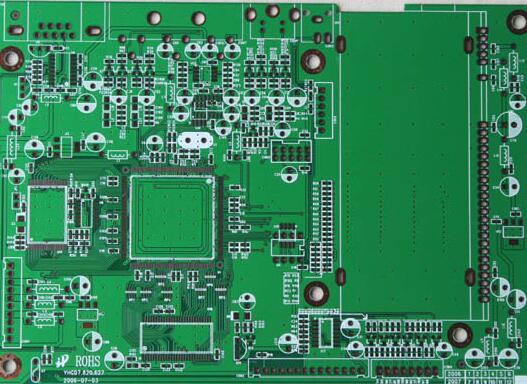Multilayer printed boards are designed for better electromagnetic compatibility. So that the printed board can meet the electromagnetic compatibility and sensitivity standards during normal operation. Proper stacking helps shield and suppress EMI.
Fundamentals of multilayer printed board design
The EMC analysis of multilayer printed boards can be based on Kirchhoff's law and Faraday's law of electromagnetic induction.
According to the above two laws, we conclude that the following basic principles should be observed in the layering and stacking of multilayer printed boards:
1. The power plane shall be as close to the grounding plane as possible and shall be below the grounding plane.
2. The wiring layer shall be arranged adjacent to the image plane layer.
3. Power supply and formation impedance. Where power impedance Z0 = where D is the distance between power plane and ground plane. W is the area between planes.
4. A strip line is formed in the middle layer and a microstrip line is formed on the surface. The two have different characteristics.
5. Important signal lines shall be close to the stratum.

Stacking and layering of PCB
1. Two layer board. This board can only be used for low speed design. EMC is poor.
2. Four layer board. There are several stacking sequences. The advantages and disadvantages of various laminations are described below.
Note: S1 signal wiring layer 1 and S2 signal wiring layer 2; GND power layer
Case a shall be one of the four ply plates. Because the outer layer is a stratum, it can shield EMI. At the same time, the power supply layer is also very close to the stratum, which makes the internal resistance of the power supply small and achieves good results. However, this case cannot be used when the density of this plate is relatively large. Because in this way, the integrity of the layer ground cannot be guaranteed, and the signal of the second layer will become worse. In addition, this structure can not be used in the case of large power consumption of the whole board.
Case B is a way we usually use. From the structure of the board, it is not suitable for high-speed digital circuit design. Because in this structure, it is not easy to maintain low power supply impedance. Take a plate 2mm as an example: Z0 = 50ohm. The line width is 8mil. The thickness of copper foil is 35 ц m. In this way, the signal is 0.14mm between the first layer and the formation. The stratum and power layer are 1.58mm. This greatly increases the internal resistance of the power supply. In this structure, because the radiation is to the space, a shielding plate needs to be added to reduce EMI.
In case C, the signal line quality on layer S1. S2 followed. It can shield EMI. However, the power supply impedance is large. This board can be used when the power consumption of the whole board is large and the board is an interference source or close to the interference source.
3. Six layer plate
Case a is one of the common ways, and S1 is a better wiring layer. S2 followed. But the power plane impedance is poor. Pay attention to the influence of S2 on S3 layer during wiring.
In case B, layer S2 is a good wiring layer and layer S3 is the same. The plane impedance of the power supply is good.
In case C, this is the case in the six layer board. S1, S2 and S3 are good wiring layers. The plane impedance of the power supply is good. The drawback is that the wiring layer is one less layer than the first two cases.
In case D, in the six layer board, although the performance is better than the first three, the wiring layer is less than the first two. This situation is mostly used in the backplane.
4. Eight layer plate
Eight layer board, if there are 6 signal layers, take case a as the case. However, this arrangement is not suitable for high-speed digital circuit design. If there are 5 signal layers, take case C as the case. In this case, S1, S2 and S3 are better wiring layers. At the same time, the plane impedance of the power supply is also relatively low. If there are four signal layers, take case B in table III as an example. Each signal layer is a good wiring layer. In these cases, adjacent signal layers shall be wired.
5. Ten layer plate
If the ten layer board has 6 signal layers, there are three stacking sequences: A, B and C. Case a is, followed by case C, and case B is poor. Other situations not listed are worse than these. In case a, S1 and S6 are better wiring layers. S2, S3 and S5 take the second place. In particular, it should be pointed out that in case a and C, the main reason why case a is better than case C is that in case C, the distance between GND layer and power layer is determined by the distance between S5 and GND layer. In this way, the power plane impedance of GND layer and power layer may not be guaranteed. Case D should be said to be the stacking sequence of comprehensive performance in ten ply plates. Each signal layer is an excellent wiring layer. E. F is mostly used for backplane. Among them, f cases have better shielding effect on EMC than E. The disadvantage is that the two signal layers are connected, and attention should be paid to wiring.
In short, the layering and lamination of PCB is a complex thing. There are many factors to consider. But we should keep in mind that the functions we want to accomplish need those key factors. In this way, we can find a delamination and lamination sequence of printed boards that meet our requirements.